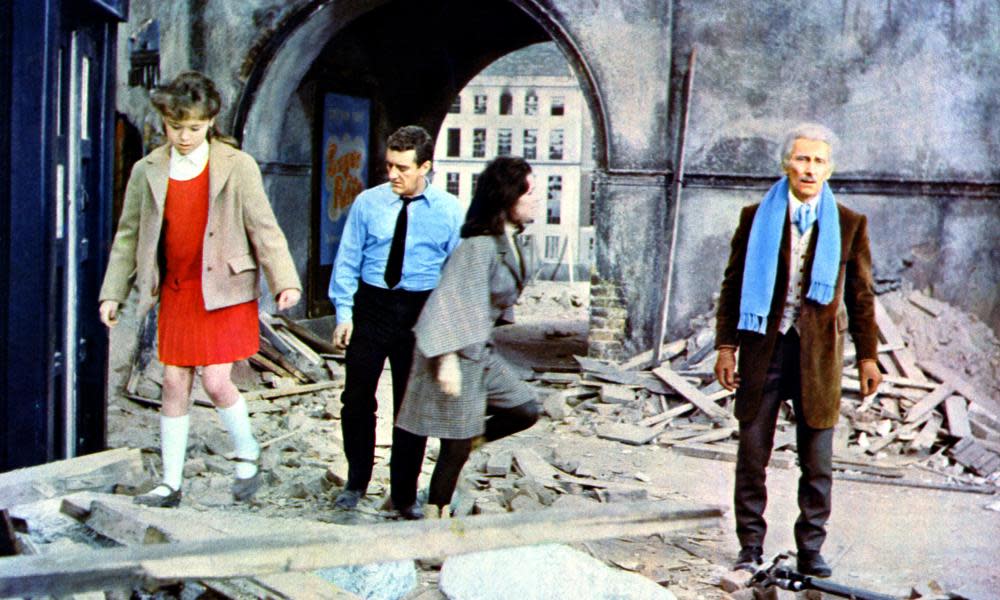Dr Who and the Daleks/ Daleks’ Invasion Earth 2150 AD review – retro Time Lord thrills

Some Whovian retro thrills are on offer here with the re-release of the two quasi-canonical Doctor Who feature films of the 1960s: Dr Who and the Daleks from 1965, and Daleks’ Invasion Earth 2150 AD the following year. These were Technicolor adventures brought to the British public by the American writer-producer Milton Subotsky under his Amicus Productions banner, known more for horror. They were adapted from existing TV plotlines and capitalised on the runaway popularity of the sinister Daleks, with their hysterically enraged metallic voices and their strange arm-pieces: all Daleks were issued with the weapon arm to zap people, but for the second, some had a claw-type grabber and others had the sink-plunger thing whose purpose is not shown here.
Peter Cushing is the Doctor, very much in the William Hartnell mode: an elegant, eccentric Edwardian-style inventor, and actually introduces himself in the first film as “Doctor Who”, as if Who is his surname. In both films, he is accompanied on his adventures by young granddaughter Susan (Roberta Tovey); in the first he is also accompanied by his daughter Barbara (Jennie Linden), and in the second by his niece Louisa (Jill Curzon), although the whereabouts and identity of Susan’s father is a mystery. And in both films, the Doctor is accompanied by a clean-cut, slightly goofy young man: Roy Castle in the first film, doing some outrageous physical-comedy pratfalls, and in the second by Bernard Cribbins. Castle and Cribbins effectively embodied the younger quirky action-lead that the Doctor was to become.
Both these films were made in rich colour and widescreen, and so the effect is very different from the downbeat noir menace of the early black-and-white TV shows, and perhaps most disconcertingly, they don’t feature the amazing electronic signature tune, which is like watching a James Bond film without the John Barry intro. But they’re still forthright and entertaining films, ambitious, imaginative, with the keynote of quirky humour and some very decent model and effects work.
Dr Who and the Daleks is really a rather soigné science-fiction-fantasy in the HG Wells mode: the Doctor takes Susan, Barbara and Barbara’s boyfriend Ian (Castle) on an accidental journey in his Tardis to a distant planet where the vicious Daleks – squidgy little creatures whose famous combat chassis is in fact a protective covering – are oppressing the peace-loving humanoid Thals, who have peroxide blond hair and natty little singlets. The Daleks, hilariously, turn out to be like dodgem fairground cars; they can be immobilised if you slide a plastic sheet under them.
Daleks’ Invasion Earth 2150 AD is very different: an altogether racier, grittier film in post-apocalyptic mode, and the Doctor’s grownup female helpmeet (Curzon) is, incidentally, just that tiniest bit sleeker and more glamorous, an inch closer to Diana Rigg in The Avengers. Cribbins’s PC Tom Campbell is caught up in the middle of a London street robbery, dives into what looks like a police box and gets carried away with the Doctor and the gang, going forward in time to the bomb-ravaged capital in the year 2150, which has been occupied by the Daleks who are hypnotising the inhabitants into being their “robohumans”. There are in fact a few scenes showing these black-clad henchmen-robohumans marching through spaceship corridors (to a grim martial theme on the soundtrack) that look like a precursor to Star Wars.
Intriguingly, we are left unsure if this film is supposed to have happened after the Daleks were defeated at the end of the previous one, and have somehow regrouped, or if it is happening beforehand. In their differing ways, these two films show us both innocence and the dystopian darkness of the Who franchise.
• Dr Who and the Daleks and Daleks’ Invasion Earth 2150 AD are released on 10 July in cinemas.

 Yahoo Movies
Yahoo Movies 
